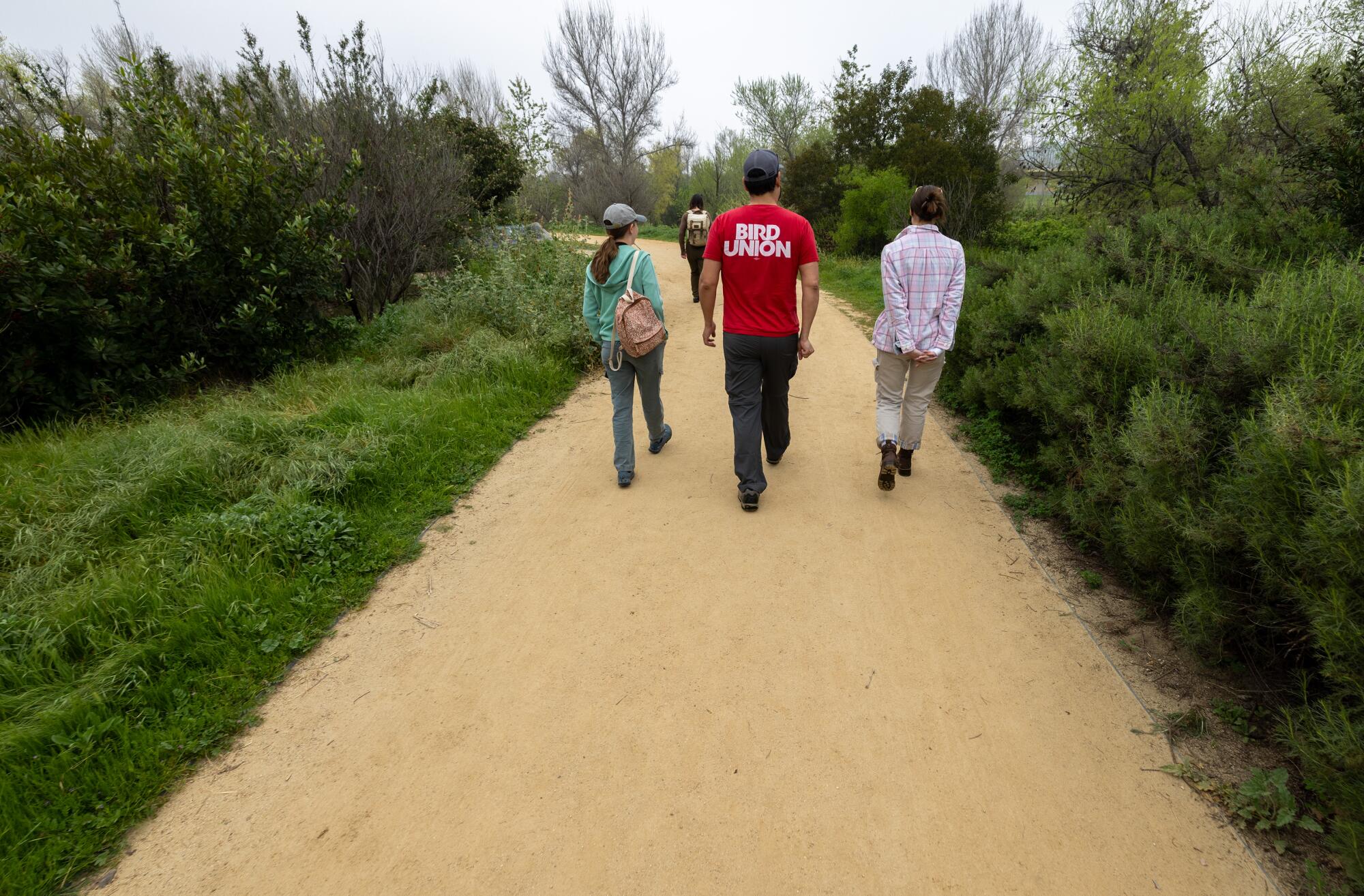
- Share via
As visitors to a bustling park in northeast Los Angeles shot hoops, scrambled up play equipment and lounged in manicured grass, an endangered songbird covertly — but not quietly — did his part to stave off extinction.
The least Bell’s vireo, a small, mostly gray songbird, was on the verge of nesting in Rio de Los Angeles State Park, a green respite that supplanted an abandoned railyard along the L.A. River. The bird with a wingspan of just seven inches was singing passionately, an act that marked its territory as breeding season picked up in mid-March. Its song rings out like a clinking question-and-answer: “Cheedle-cheedle-chee? Cheedle-cheedle-chew!”
“It’s persistent. It’s a survivor,” said Nicolas Gonzalez, senior communications manager for migration science at the National Audubon Society, an avian conservation nonprofit, who helped identify the bird as it flitted between trees, blending into the muted spring sky.
Aggressive and impactful reporting on climate change, the environment, health and science.
Bird boosters, meanwhile, were hustling to get the grounds in order.
Evelyn “Evy” Serrano enthusiastically instructed two volunteers at Rio de Los Angeles, which is in the Glassell Park neighborhood, on how to create what looked like moats of soil around fledgling native plants. Serrano, director of the Audubon Center at Debs Park, another urban oasis, explained that the berms would funnel water to the mule fat, black sage, golden currant, sycamore trees and other native foliage the least Bell’s vireo needs to thrive. Certain plants provide cover and nest materials, while others attract yummy insects.
1
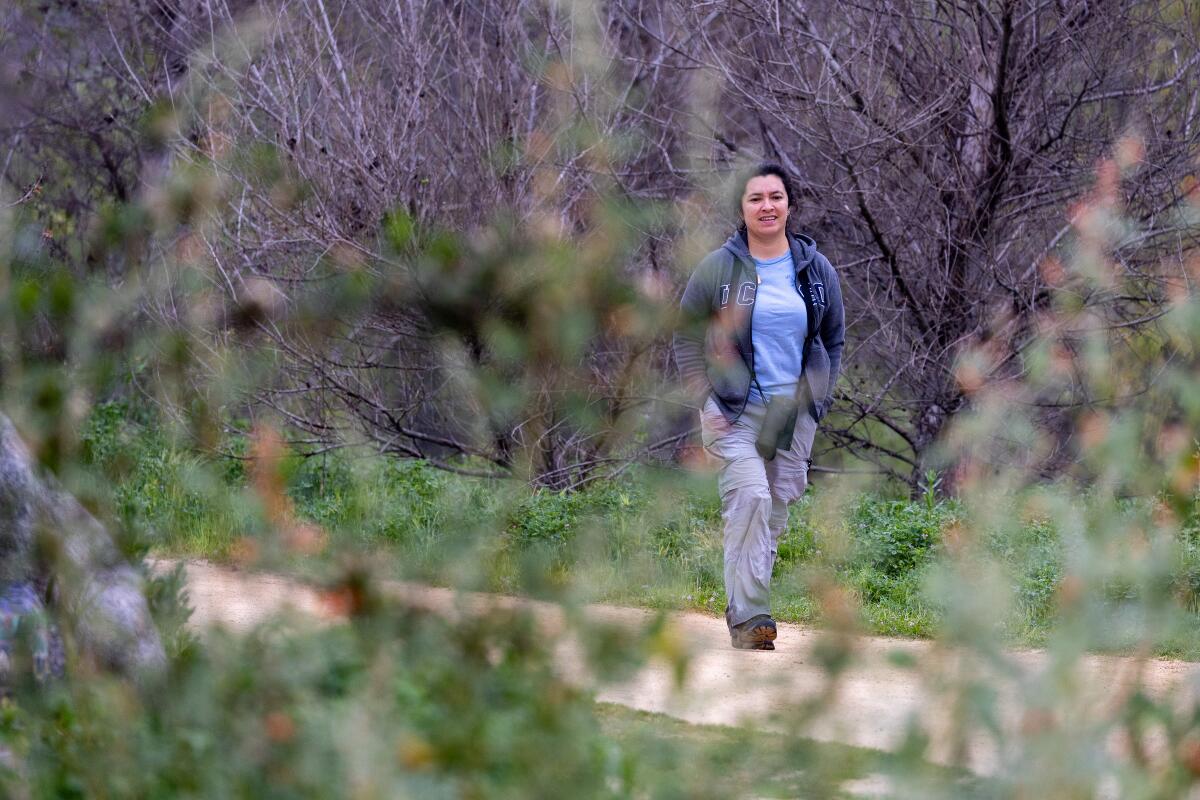
2
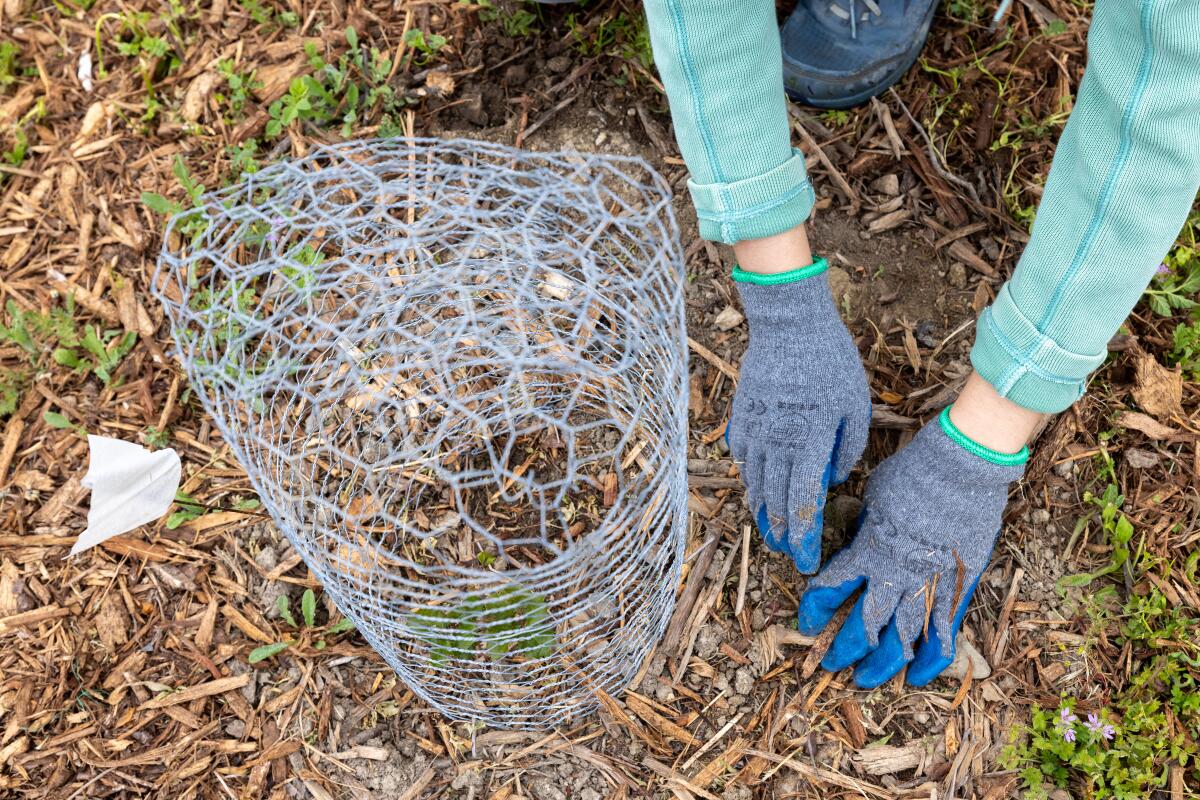
3
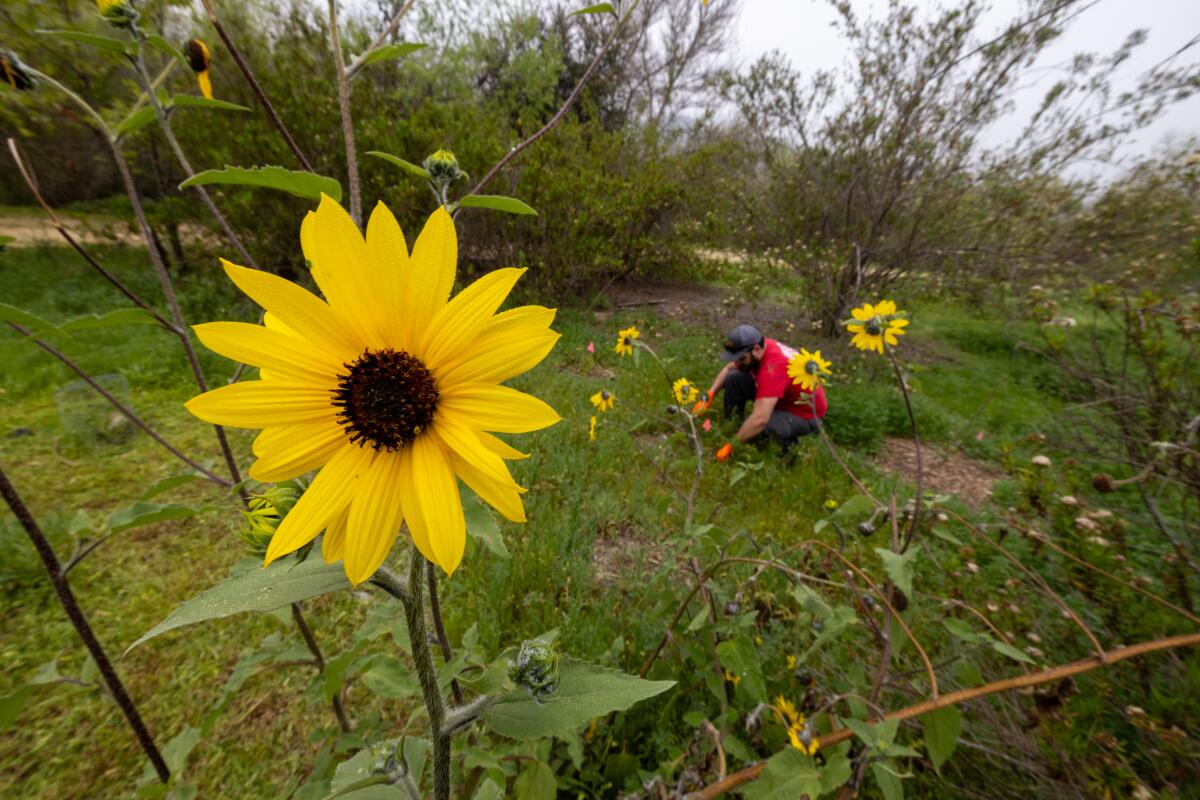
4
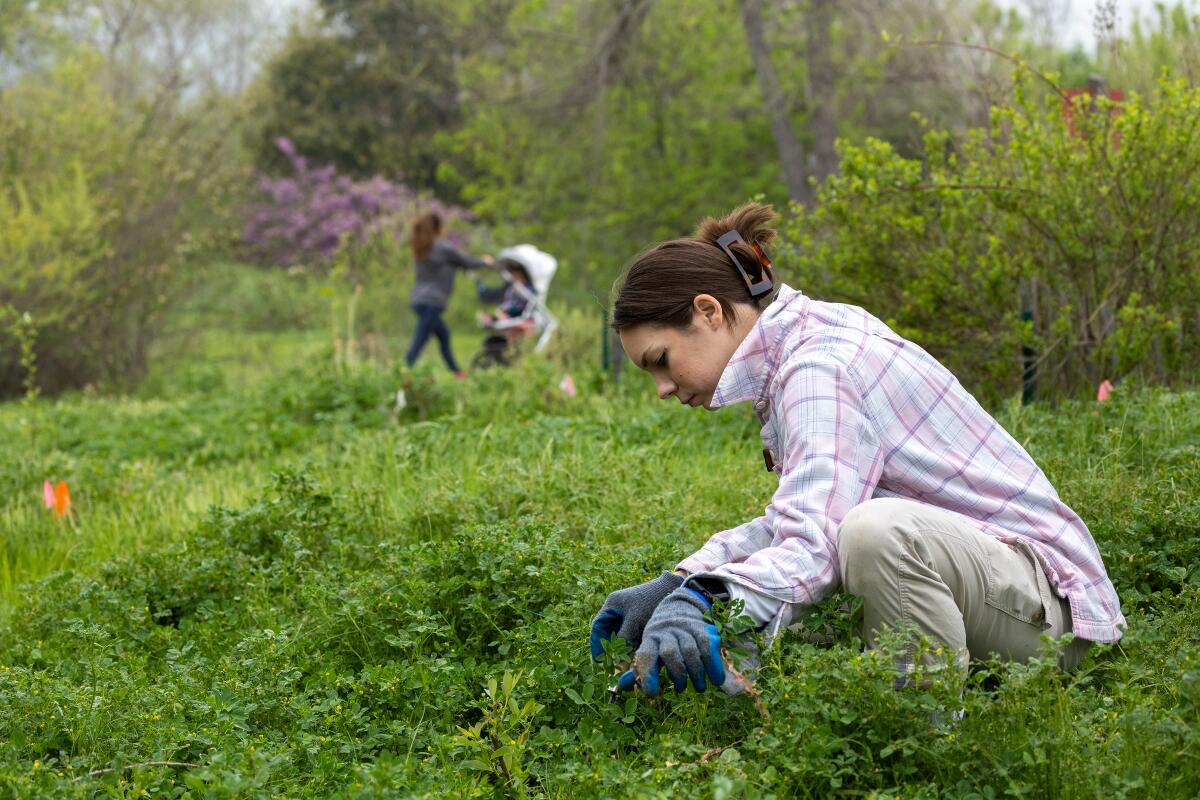
1. Evelyn Serrano of the Audubon Center at Debs Park strolls at Rio de Los Angeles State Park in March. 2. A volunteer removes weeds. 3. Nicolas Gonzalez of the National Audubon Society pulls weeds among blooming sunflowers. 4. Audubon’s Rachel Bailey pulls up nonnative clover. (Brian van der Brug / Los Angeles Times)
So far, the literal dirty work seems to be paying off. A lone least Bell’s vireo was documented at the park when the habitat restoration effort targeting the species began about two years ago, Serrano said. Within a year, there were four — two nesting pairs. Last year, they counted three fledglings.
“Sometimes it takes a really long time to see the change,” Serrano said. “It was really nice to see it happen so quickly.”
Stakeholders see the migratory birds’ rebound in the park and surrounding areas as a testament to what can happen when people come together to make positive change and natural environments are supported. It also suggests that people can live in harmony with nature — even in highly urbanized areas.
But significant legwork preceded the recent local triumph, and what can be seen as historic missteps were walked back. Meanwhile, there are new and old threats.

Subscribers get exclusive access to this story
We’re offering L.A. Times subscribers special access to our best journalism. Thank you for your support.
Explore more Subscriber Exclusive content.
Once abundant in California’s riverside woodlands, the silver-tongued, whitish-bellied least Bell’s vireo vanished from most of its range by the 1980s, remaining only in Southern California and northern Baja California, according to the U.S. Geological Survey. (The birds are the smallest of four subspecies of Bell’s vireo.)
The ranks plummeted amid the extensive loss of their preferred riparian habitat. Dams went up and wetlands were drained, people encroached on wildlands, and agriculture expanded. In 1999, The Times reported that California had lost 97% of its riparian woodlands, more than any other state. Parasitism by brown-headed cowbirds, which lay eggs in vireo nests, contributed to the decline. California listed the bird as endangered in 1980, and federal officials followed suit in 1986.
About 20 years after the least Bell’s vireo gained federal protection, the California population increased almost tenfold, from 291 to 2,968 pairs, according to federal wildlife officials. Now the birds are popping up in areas where they haven’t been seen in years, sometimes even decades.
The Rio de Los Angeles park site was once part of the floodplain of the nearby Los Angeles River — prime vireo real estate. Then came the concrete. Catastrophic floods, including one in 1938 that killed more than 100 people and delayed the Oscars, prompted the waterway to be paved over.
That ushered in a period of about 60 to 70 years “where you would never have seen a least Bell’s vireo anywhere near downtown,” said Dan Cooper, deputy executive officer and senior conservation biologist for the Resource Conservation District of the Santa Monica Mountains.
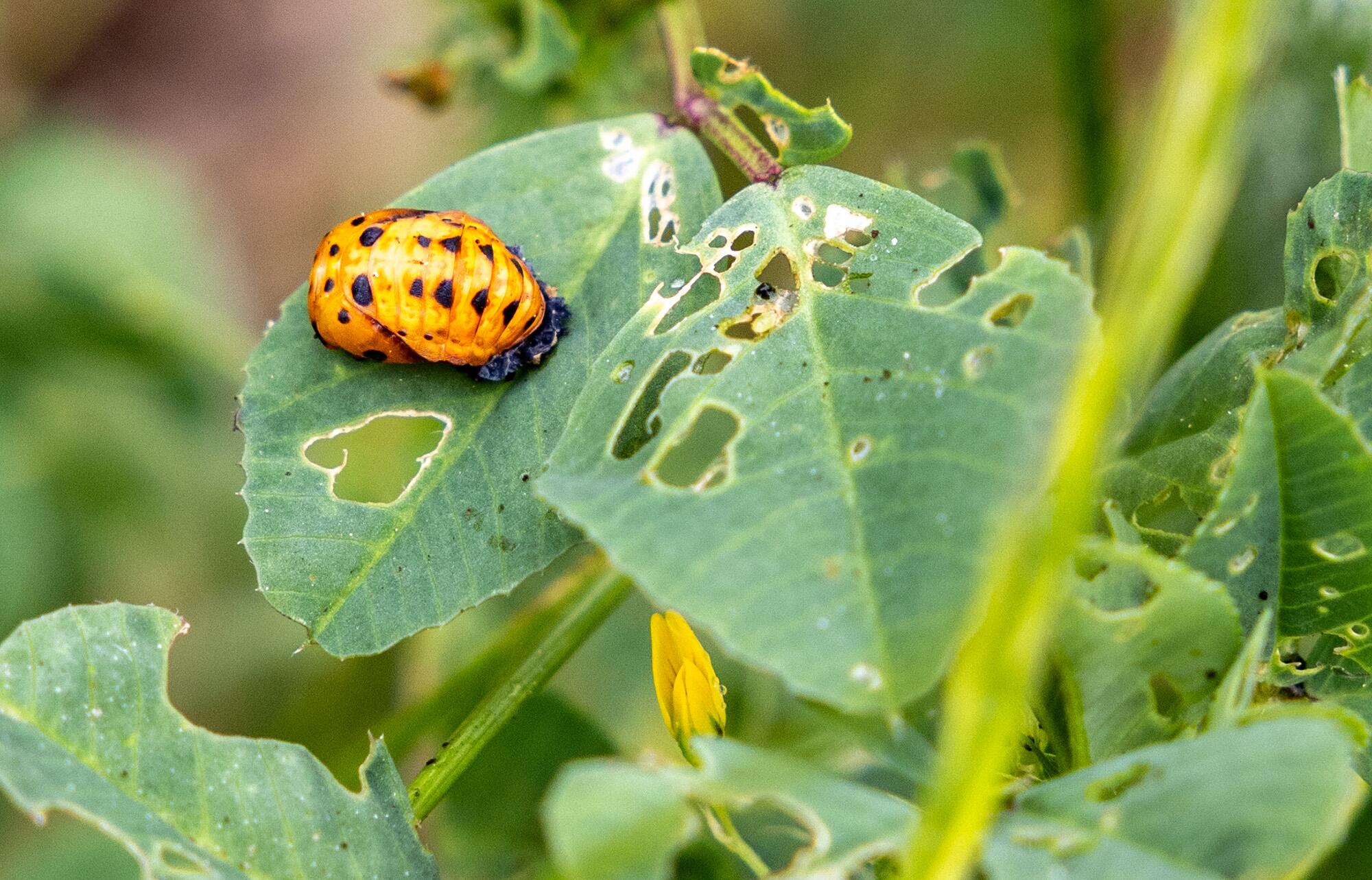
A turning point arrived in the late 1990s and early 2000s, he said, when restoration work along the river began, and government agencies started clearing less habitat in the channel. Cooper, a San Gabriel Valley native, joined Friends of the L.A. River just as the nonprofit was launched by poet Lewis MacAdams.
Two years ago, Cooper was shocked to trace the birds to a pocket park lodged between the river and the roaring 5 Freeway. There was a youngster accompanying the adult making a begging call for food and attention.
“Its song is so distinctive, and it really cuts through all the din of the city noise,” Cooper said. “I could hear it above the traffic.”
On a podcast, Cooper calls it a “scratchy phrase that goes up and then goes down.” He added: “It was described to me as, ‘You take the ball, give it to me; I take the ball, give it to you.’”
The same year, Cooper said, a territory cropped up at a picnic area in Elysian Park. He said Chavez Ravine was likely once a “nice little riparian spring” replete with blackberries and other goodies.
“Once they start kind of reclaiming their prior territory, they seem to be spreading out into places we don’t necessarily expect to find them, like Elysian Park,” he said. It appears 2022 marked when the birds “sort of exploded” in the area.
Sign up for This Evening's Big Stories
Catch up on the day with the 7 biggest L.A. Times stories in your inbox every weekday evening.
You may occasionally receive promotional content from the Los Angeles Times.
Marcos Trinidad, senior director of forestry at TreePeople, remembers hearing the unmistakable tune while strolling through Rio de Los Angeles around 2015. Trinidad, who learned the call by listening to a CD he burned featuring classical music interspersed with birdsongs, recalled thinking, “Whoa, wait, is that really happening here?”
At the time, he was director of the Audubon Center at Debs Park, and he was able to secure funding about two years later that allowed for consistent habitat restoration events.
A National Fish and Wildlife Foundation grant funds the restoration happening today, Serrano said. In addition to Audubon, the work is supported by California State Parks, Los Angeles River State Park Partners, Theodore Payne Foundation and Terremoto. Other groups, such as Friends of the L.A. River, carry out nearby restoration efforts that benefit the birds.
Rio de Los Angeles is a fairly young park; it opened in 2007 on Taylor Yard, a former Union Pacific railroad maintenance depot. Tracks still border one side of the park, and trains hurtle by in deafening bursts.
A contentious compromise between city and state officials birthed a unique park: Reconstructed wetlands lush with native flora border facilities that include a soccer field, recreation building and playground. Most visitors are unaware they’re walking their pooch or dribbling a ball yards from what has become refuge for an embattled songbird.
Those with historical knowledge of the area logged the change. An employee with L.A.’s Department of Recreation and Parks showed a Times reporter a satellite image that apparently captured the area before it was rehabbed. Trees were sparse.
“There was nothing here, and they revitalized it,” said the employee, who was working at the park.
Vector control officials in Southern California are starting to release sterilized male mosquitoes to combat the summertime onslaught of ankle biters.
Gray and orange fencing now rises in parts of Rio de Los Angeles State Park, barriers between nesting activity and the public. As of mid-May, two nests were confirmed. Serrano, in an email, said “our bird friend” continued to sing “a whole lot.”
Moses Goldfarb, 31, was unaware of the vireo when he arrived at the park on a sunny day in April to play tennis. The Seattle transplant, who works in the film industry, expressed surprise that the park was home to “anything other than just a standard city bird.”
Ariana Martinez, 23, who was lounging on a grassy patch, was less thrown by the revelation that the songbird was near. Since discovering the more naturalistic side of the park a few months ago, she frequents it, along with her young nephew and elderly dog.
Given all the trees and ambient bird sounds, “I feel like it makes sense for them to be here,” she said.

Candice Dickens-Russell, chief executive of Friends of the L.A. River, said nature is especially thriving in three areas of the river where those who paved it couldn’t get the concrete to stick: near Long Beach, the Sepulveda Basin and Glendale Narrows. She said it’s those places where the least Bell’s vireo and other species are making a comeback.
“There is definitely a link between a lack of concrete and biodiversity,” she said, adding that the nonprofit is advocating for strategic removal of concrete in areas of the river where it’s safe to do so.
Preserving the least Bell’s vireo, of course, goes beyond the river.
The pup could become Aquarium of the Pacific’s first surrogate-raised otter to return to the wild — if she masters the skills needed to hack it in the ocean.
A group spanning academic, military and conservation partners is developing a model to examine all identified threats to the bird “in a kind of holistic way over space and time so we can say what are the major threats that need to be managed and where,” said Casey Lott, a consultant for the project who owns Conservation Science and Data Visualization.
Several of the birds’ largest remaining nesting habitats are on U.S. Department of Defense training areas and in U.S. Army Corps of Engineers flood control basins, and managing them in accordance with federal wildlife law is costly and disruptive to agency operations, according to an overview of the project. (In 1986, a pair of wildlife biologists penned an op-ed for The Times pushing back on what they described as unfair “villification” of the bird after it earned federal protections, which some blamed for derailing projects.)
Lott said the birds are on the rise, estimating that there are between 4,630 and 5,125 pairs, but they haven’t established themselves in the Central Valley, once believed to be the heart of their range. According to Lott, there’s ample habitat for them there, as well as in other areas in the state, but they remain stymied by cowbirds. Meanwhile, they’re expanding in areas where cowbirds are amply trapped.
“So we can increase the population now with a whole lot of cowbird control,” Lott said. “But if the species is delisted and those efforts stop, it’s hard to imagine it not going back to dire straits.”
The model, which will take into account climate change and other emerging threats, is expected to be completed in 2026.
